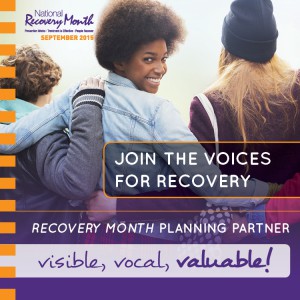By Jenna Cerruti, August 17 2015
 The Substance Abuse and Mental Health Services Administration (SAMHSA) is gearing up for its 26th year hosting Recovery Month, a national observance to promote awareness around substance use treatment and mental health services.
The Substance Abuse and Mental Health Services Administration (SAMHSA) is gearing up for its 26th year hosting Recovery Month, a national observance to promote awareness around substance use treatment and mental health services.
As a champion for better treatment for adolescents, Reclaiming Futures echoes SAMHSA’s Recovery Month message that behavioral health is essential to overall health. We’ve seen tremendous gains across our 42 sites among teens who have received substance use treatment or mental health services, connected with mentors and natural helpers, and immersed back into their communities in productive ways. Mia’s story in Snohomish County is just one example of this.
In addition to Mia, there are millions of Americans whose lives have been transformed through recovery. Recovery Month is a time for these people to celebrate and speak about their accomplishments, extend the awareness of the importance of treatment and recovery, and encourage those struggling to seek help.
As leaders in the behavioral health and juvenile justice field, you can help promote Recovery Month to your networks and communities. SAMHSA offers a comprehensive toolkit [PDF] to make it easy. Check out these top four, simple ways to promote better treatment during Recovery Month:
- Generate Media Attention for Your Program:
Because of its national prominence, National Recovery Month is a fantastic news hook for your organization or treatment program to get noticed by local media. Reporters will be interested to know how your program is supporting vulnerable communities, and specifically what your recovery impact is on your community. Consider pitching reporters a package complete with specific data points and a personal story, or submitting an op-ed tied to Recovery Month. The toolkit shares step-by-step practical tips for conducting media outreach, particularly around your Recovery Month event.
- Support Natural Helpers
Family members, peers, teachers or other natural helpers close to the youth are often the first to recognize a mental and/or substance use disorder. This close knit community is also critical to recovery, monitoring and promoting positive behavioral health. During Recovery Month and beyond, consider partnerships with family support groups, outreach to county or health department officials to arrange guest-speaking opportunities to educate families about recovery, or developing a resource guide to support natural helpers through their journeys with a person in recovery.
- Share Stories
Stories of recovery are powerful. They evoke emotion and help your audience visualize what treatment actually looks like. SAMHSA offers several personal stories in its toolkit, but consider sharing stories related to your own behavioral health program with your networks or community members to grab their attention, promote treatment and drive awareness of your organization.
- Join an Event
You don’t have to host and coordinate an event all on your own. SAMHSA has tracked and published all Recovery Month events that you can search for by state. Encourage your staff to attend a local event to show support — you may find new local connections or potential partners that can help advance your work.
How are you celebrating Recovery Month? Share your thoughts for how juvenile justice and behavioral health leaders can promote this important national observance.
Topics: Adolescent Mental Health, Adolescent Substance Abuse Treatment, News, Positive Youth Development, Resources
Updated: February 08 2018
